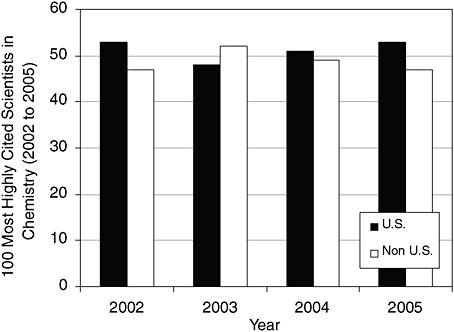3
Current Research Leadership Position
To determine the overall position of U.S. research in chemistry relative to research performed in other regions or countries, the panel analyzed journals (paper authorship, most highly cited articles, most accessed articles, and hot papers), international congress speakers, and prizes. Most of these measures have previously been used to assess quality of science; however, in addition, the panel used virtual congress evaluations to determine the leadership groups within each subarea. The limitations of each individual measure were recognized, and therefore, the panel analyzed the collective results of all of the indicators to draw conclusions regarding relative research competitiveness.
APPROACH
In this part of the overall benchmarking study, the panel tried to collect objective information as much as possible, but it also recognized its responsibility for making collective subjective judgments when needed. In addition, certain boundaries were needed to keep the exercise timely and relevant to the broad chemical enterprise.
In this exercise the panel considered individual countries and geographic regions, which include the United States (including Puerto Rico and any U.S. territories), Canada, Western Europe (including Greece), Japan, Asia, and “Other.”1
The assessment begins with an overall view of leadership in chemistry at large, looking broadly at science and engineering (S&E) and chemistry research outputs. This largely includes an analysis of journal articles and citations, virtual congress results, and to a lesser extent, information on international congresses and prizes. Finally, the areas of chemistry are described and assessed.
JOURNAL ARTICLE CONTRIBUTIONS
Publication of research results is essential for scientific and technological progress and leadership. Thus, looking at quantity and quality of journal articles being published in the world is one important and largely objective measure of scientific research leadership. For this analysis the panel selected a list of leading journals, with high impact factors. The impact factor is a measure of the frequency with which the “average article” in a journal has been cited. The impact factor of a journal is calculated by dividing the number of current year citations to the source items published in that journal during the previous two years. Given the broad range of journals in which chemists publish, and in an effort to assess current trends in the directions of fundamental chemistry research, the panel selected the journals as follows:
-
Journals with broad coverage of S&E disciplines, in which chemists publish (e.g., Science, Nature)
-
Journals with broad coverage of chemistry (e.g., Journal of the American Chemical Society, Angewandte Chemie)
-
Leading journals for each subarea of chemistry:
-
Area-specific journals where chemistry researchers are the primary contributors (e.g., Analytical Chemistry, Inorganic Chemistry)
-
Area(s)-specific journals where researchers from various sciences and/or engineering disciplines publish, along with researchers from chemistry (e.g., Nature Materials, Physical Review Letters)
-
The full list of all journals considered by the panel is given in Table C-1 in Appendix C.
The panel focused its analysis of journal publications data on the following metrics:
-
Publication rates over roughly the past 15 years (1988 to present) in all of science and in chemistry.
-
Percent contributions by U.S. researchers in all areas of science versus those from other countries or regions.
-
Percent contributions by U.S. chemists versus those of chemists from other regions.
-
Percent of papers in the list of 100 most cited papers for the periods 1990-1994, 1995-1999, and 2000-2006.
To assess research leadership the panel concentrated on percent of hot papers, percent of highly cited papers, and the virtual congress results, which will be defined in more detail later in the report. For these criteria the following metric was used:
-
Greater than 75 percent: the strong leader
-
Greater than 50 percent: the leader
-
Greater than 30 percent: among the leaders
-
Less than 30 percent: lagging behind the leaders
Here, we first look at the numbers of journal articles being published in S&E overall, in chemistry, and finally in chemistry area-specific journals. It is important to note that the overall percentage of papers contributed by a particular country indicates only the quantity of work performed, rather than quality. That is why numerous other metrics were applied to the assessment to gauge the quality of the chemistry research produced by each country.
Decreasing U.S. Share of S&E Journal Articles
Examination of the number of articles published annually in the scientific literature on a regional basis shows that the profile of scientific activity worldwide has changed dramatically over the past 15 years (see Figure 3-1). The long-standing scientific dominance of the United States persists, but other areas of the world are closing the gap. In 1988 the United States was the largest contributor to S&E publications, even when compared to other regions. While the absolute number of U.S. S&E papers grew by 19 percent between 1988 and 2003, the output of articles from Western European nations combined increased by 67 percent and surged past the U.S. total. Dramatic growth was seen for papers from Korea, which grew 1,683 percent from 771 to 13,746; China, 630 percent from 4,001 to 29,186; and Taiwan, 556 percent from 1,414 to 9,270. The percentage of papers from Asia and the subcontinent as a whole, which include China and India, has increased by a factor of 2.5, from 4 percent to 10 percent of all articles. The percentage of all S&E articles from U.S. authors dropped from 38 to 30 percent between 1988 and 2003.

FIGURE 3-1 Numbers of all S&E articles for select countries and regions.
NOTE: Publication counts from set of journals classified and covered by Science Citation Index and Social Sciences Citation Index. Articles assigned to region/country/economy on the basis of institutional address(es) listed in article. Articles on fractional-count basis; i.e., for articles with collaborating institutions from multiple countries/economies, each country/economy receives fractional credit on the basis of proportion of its participating institutions.
SOURCE: Regional and country portfolio of S&E articles, 1988, 1996, 2001, and 2003. National Science Foundation, 2006 Science and Engineering Indicators.
The Fastest-Growing Economies Have Increased Their Share of U.S. Patent Applications
While the number of U.S. patent applications from U.S. inventors more than doubled from 91,000 in 1990 to 189,000 in 2003, the percentage held steady at 55 percent.2 In contrast, U.S. patent applications from the fastest-growing economies (China, Hong Kong, India, Ireland, Israel, Singapore, South Korea, and Taiwan) increased more than eightfold from 3,800 in 1990 to 30,800 in 2003; their share of U.S. patent applications more than tripled, from 2.3 to 9.0 percent.
TABLE 3-1 Top 10 Chemistry Paper Producing Countries (for 10-Year Period, Jan. 1996 to Nov. 2006)
|
Rank |
Country |
Population (2006 est. in millions) |
Chemistry Papers |
Chemistry Papers/Million Inhabitants |
Total Papers |
|
1 |
United States |
300 |
217,791 |
726 |
2,831,004 |
|
2 |
Japan |
128 |
117,085 |
915 |
771,573 |
|
3 |
Peoples Republic of China |
1,300 |
102,047 |
78 |
400,917 |
|
4 |
Germany |
82 |
95,815 |
1168 |
723,435 |
|
5 |
France |
61 |
64,121 |
1051 |
522,015 |
|
6 |
Russia |
143 |
60,765 |
425 |
280,480 |
|
7 |
England |
61 |
57,199 |
938 |
643,557 |
|
8 |
India |
1,100 |
47,556 |
43 |
203,989 |
|
9 |
Spain |
40 |
40,179 |
1004 |
254,808 |
|
10 |
Italy |
58 |
39,141 |
675 |
358,452 |
|
SOURCE: Thomson ISI Essential Science Indicators and U.S. Census Bureau, International Database. |
|||||
Decreasing U.S. Share of Chemistry Papers
The number of a nation’s chemistry papers provides a quantitative measure of research activity in chemistry. According to Thomson ISI (which counts chemistry papers somewhat differently than the National Science Foundation (NSF)), U.S. chemists published more papers than those from any other country between 1996 and 2006 (see Table 3-1), accounting for about 18 percent of the total papers.3 The U.S. total is nearly twice that of second-ranked Japan. However, in looking at the numbers of chemistry papers published per million inhabitants, Germany ranks first and the United States is sixth. In addition, compared to other regions (see Figure 3-2), the United States ranks second to Western Europe and just slightly ahead of Asia.
The trends in publication of chemistry papers show a leveling of U.S. activity in chemistry and growth in the rest of the world, except for the former Soviet republics (see Figure 3-3). Over the past decade the number of U.S. chemistry papers has remained relatively steady at about 15,000 annually. According to the NSF data shown, between 1988 and 2003 the percentage of articles contributed from both Western Europe and the United States dropped somewhat (from 22.9 to 19.1 percent for the United States), while the percentage from Asia (not Japan) more than tripled and now nearly matches the U.S. contribution.
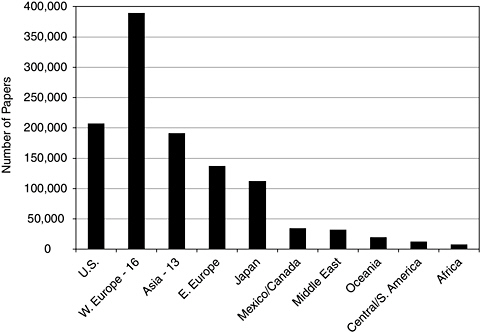
FIGURE 3-2 Comparison of select country and regional production of chemistry papers, 1996 to June 2006.
SOURCE: Thomson ISI Essential Science Indicators. Central/S
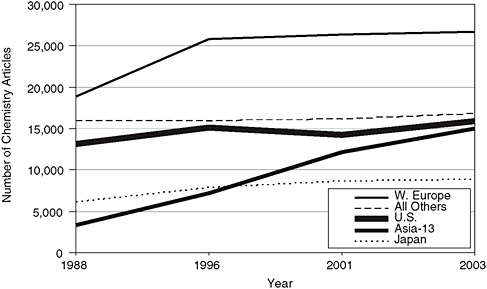
FIGURE 3-3 Numbers of chemistry articles published in the world for select countries and regions.
SOURCE: Regional and country portfolio of S&E articles, 1988, 1996, 2001, and 2003; National Science Foundation, 2006 Science and Engineering Indicators.
Figure 3-4 illustrates changes occurring in the contribution of U.S. and non-U.S. authors to American Chemical Society (ACS) journals. Since ACS journals are largely published in the United States by a U.S. organization, it is expected that U.S. authors would make the greatest contribution to these journals. However, the percentage of papers published by non-U.S. authors in American Chemical Society (ACS) journals has increased from 57 to 61 percent in the past six years shown. Contributions from Asia (largely due to China) doubled, from 6 to 12 percent. The increase in international papers in ACS journals reflects both the increasing popularity of the journals and the increasing ease of submitting papers electronically. It also indicates that the quality of non-U.S. papers is improving.
Figure 3-5 shows the declining percent contributions of U.S. authorship in ACS journals for specific areas of chemistry.
Chemistry Has a Small but Steady Share of U.S. S&E Article Output
Only 8 percent of U.S. S&E articles are in chemistry, compared to the world average of 12 percent (see Figure 3-6). While the United States contributes 30 percent of the S&E articles, it contributes only 19.1 percent of the chemistry articles. The U.S. position may be indicative of a more diverse research portfolio or an emphasis on biomedical-related fields (see Figure 3-5). This trend may also be related to an increasing number of
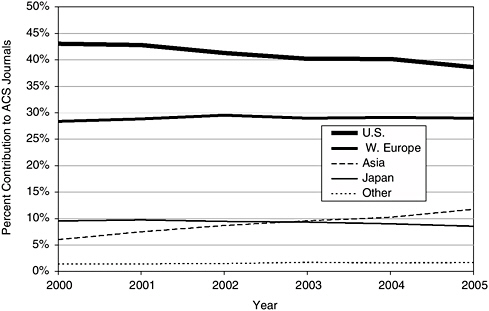
FIGURE 3-4 Percent contribution to all ACS journals from select regions.
SOURCE: American Chemical Society, Publications Division.

FIGURE 3-5 Percent contributions of U.S. authors to ACS journals by (a) traditional and (b) emerging areas of chemistry.
SOURCE: Analysis of data provided by ACS Publications Division.

FIGURE 3-6 Percentage of a country’s articles that are in chemistry.
SOURCE: Regional and country portfolio of S&E articles, 1988, 1996, 2001, and 2003; National Science Foundation, 2006 Science and Engineering Indicators.
publications in leading journals of other disciplines, due to the highly multidisciplinary nature of chemistry, especially in the United States.
Figures 3-7, 3-8, and 3-9 show the different research portfolios of the United States, China, and India for 1996 and 2003.
So far only data on the number of articles published in all of S&E and then in chemistry have been presented. The next section presents data that measure the impact and quality of publications. This information provides another measure of research leadership.
JOURNAL ARTICLE CITATIONS
This section looks at research quality through further analysis of article citations and papers deemed “hot” by Thomson ISI or that are most accessed through the ACS website.

FIGURE 3-7 Research portfolio of the United States, 1996 and 2003.
SOURCE: National Science Foundation, 2006 Science and Engineering Indicators.
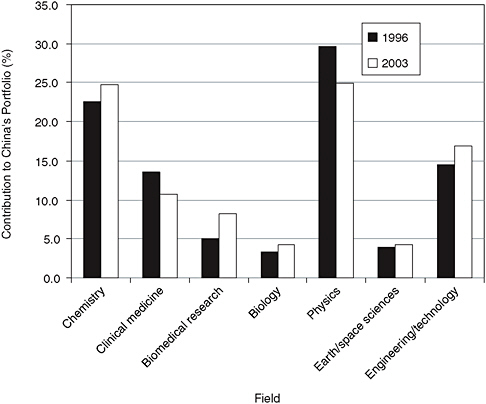
FIGURE 3-8 Research portfolio of China, 1996 and 2003.
Erosion of U.S. Lead in Journal Article Citations in Science and Engineering
As mentioned earlier, Western Europe surpassed the United States in total S&E publications in 1997. While the United States still leads Western Europe in number of citations, the gap is narrowing (see Figure 3-10). The erosion of U.S. leadership in citations is due both to the increased number of publications and to the increased number of citations per paper from Europe. These data provide evidence that both the quantity and the quality of papers from Western Europe are increasing.
U.S. Chemistry Leads in Total Citations and Citations per Paper
The total number of citations of chemistry articles provides a measure of the strength of a nation’s contributions to chemistry, and the number of citations per paper gives information on the average impact of a nation’s chemistry papers. The United States ranks first both in total citations and in
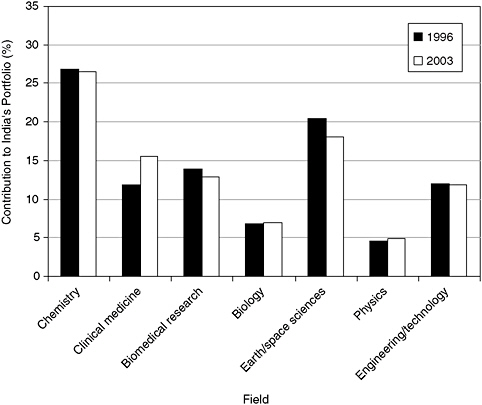
FIGURE 3-9 Research portfolio of India, 1996 and 2003.
SOURCE: National Science Foundation, 2006 Science and Engineering Indicators.
citations per article in chemistry (see Table 3-2 and Figure 3-11). While U.S. authors published 18 percent of chemistry articles, their papers received 28 percent of the total world citations over the past 10 years.4 Thus, although the United States lags behind Western Europe in terms of number of chemistry articles (Figure 3-3), the average impact of a U.S.-authored article, measured by citations, is substantially greater than for those from Western Europe and other regions.
Strong but Declining U.S. Contribution to Highly Cited Chemistry Articles
To assess the national origin of the highest-quality papers, the top 100 most highly cited papers in chemistry over the past 10 years were exam-
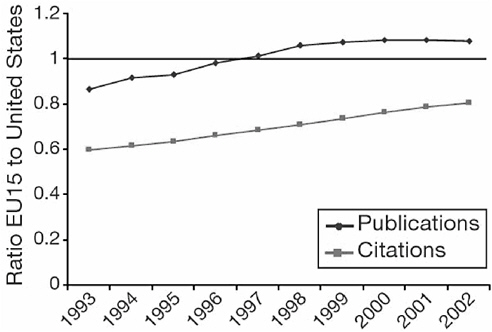
FIGURE 3-10 Ratio of publications and citations of the 15 European Union countries in the comparator group (EU15) to the United States on ISI databases 1993-2002.
NOTE: The EU15 total contains some duplication because of papers jointly authored between countries in the EU group. Counts for papers and citations are totals for country (or group) for the stated year.
SOURCE: D.A. King, “The scientific impact of nations,” Nature, 430:311-316 (2004). Adapted by permission from Macmillan Publishers Ltd.
ined (see Figure 3-12). The leadership of the United States is shown by authorship of 50 percent of the papers. The strongest competition comes from Western Europe (consisting mostly of contributions from Germany, England, France, Spain, and Italy). The percentage of most highly cited papers shown here for the United States is two to three times greater than the percentage of U.S.-authored chemistry papers.
However, the U.S. share of highly cited papers shown in Figure 3-12 does not indicate whether the U.S. contribution is changing. To assess recent trends, the panel looked at the most frequently cited articles in a select group of chemistry journals. As shown in Figure 3-13, there was a slight decline in U.S. authorship from 53.5 to 47.2 percent from 1990-1994 to 2000-2006 and a nearly fourfold increase in Asian authorship from 1.5 to 5.6 percent (Asia includes India and China but not Japan).
TABLE 3-2 November 2006 Ranking of Countries by Citations of Chemistry Articles and Citations per Paper (10-Year Period, 1996-2006)

FIGURE 3-11 Highly cited countries and regions in chemistry (citations/article), 1996 through June 2006.
NOTE: ISI provides citation rankings for what are defined as chemistry-related journals based on past 10 years, plus partial-year counts for the current year. Data shown were collected in June 2006.
NOTE: E. Europe = Russia, Eastern Europe, former Soviet Bloc.
SOURCE: Thomson ISI Essential Science Indicators.
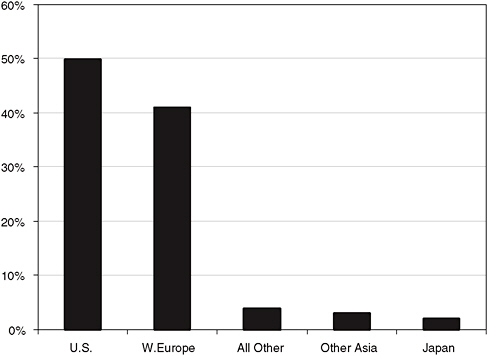
FIGURE 3-12 Percent contribution to top 100 most cited papers in chemistry for 1996-2006.
SOURCE: Thomson ISI Essential Science Indicators, accessed June 22, 2006.
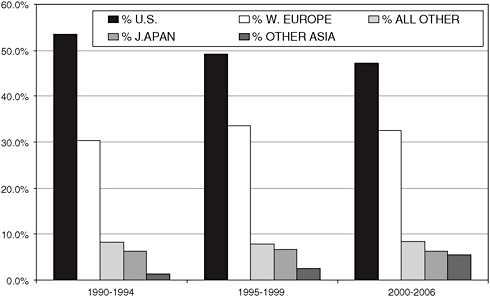
FIGURE 3-13 Regional/country breakout of most highly cited chemistry articles of all journals considered. (See also Appendix C, Table C-2.)
U.S. contributions to the most cited articles in specific areas of chemistry are shown in Table 3-3. These results are discussed in more detail in the area assessments later in this chapter; however, it should be noted here that the trends in U.S. contributions vary significantly across the areas. While most areas show steady or declining U.S. contributions, analytical chemistry shows strong gains.
Strong and Steady U.S. Share of Highly Cited Chemists
Examination of the national origin of the most highly cited chemists provides another indication of a nation’s strength in chemistry. About 50 percent of the most highly cited chemists are from the United States (Figure 3-14). This is a much larger percentage than the 19 percent U.S. contribution to all chemistry articles and the 28 percent U.S. contribution to all chemistry citations over the past 10 years.
Strong U.S. Contribution to Chemistry “Hot” Papers
The number of so-called hot papers provides another indicator of research quality. According to Thomson ISI, most papers reach their citation peak two to four years after publication, but some papers are recognized as hot and receive significant numbers of citations soon after publication. Often these papers are the key papers in their fields. Figure 3-15 shows country or regional contributions to the top 100 hot papers in chemistry
TABLE 3-3 Percent U.S. Authorship of Most Frequently Cited Articles in Journal Articles Compiled by Area of Chemistry
|
U.S. %, Most Highly Cited by Area |
1990-1994 |
1995-1999 |
2000-2006 |
|
U.S. % |
U.S. % |
U.S% |
|
|
Multidisciplinary science |
74.0 |
72.0 |
72.0 |
|
Multidisciplinary chemistry |
48.0 |
27.6 |
37.2 |
|
Analytical chemistry |
37.5 |
48.8 |
49.3 |
|
Biological chemistry |
55.9 |
57.4 |
54.4 |
|
Chemical education |
|
74.0 |
68.0 |
|
Environmental |
49.0 |
36.7 |
30.0 |
|
Inorganic |
51.0 |
38.5 |
40.5 |
|
Macromolecules |
46.3 |
34.0 |
34.7 |
|
Materials science |
33.0 |
44.5 |
41.2 |
|
Organic chemistry |
59.5 |
58.8 |
47.0 |
|
Physical an computational |
51.5 |
47.3 |
49.8 |
|
ALL |
53.5 |
49.1 |
47.2 |
for 2004-2006. Once again, the United States shows strong leadership, with Western Europe following closely behind.
The largest number of hot papers in chemistry are in the areas of materials/nanoscience, organic chemistry, and inorganic chemistry (see Figure 3-16).
Although the U.S. contribution to hot papers is dominant, it varies significantly across the areas of chemistry (Figure 3-17). In the three areas of chemistry that dominate the hot papers, the United States contributed the most in materials/nanoscience, whereas Western Europe contributed the most in organic and inorganic chemistry.
Recently, the ACS has begun to highlight the top 20 “most accessed” articles in its journals. This provides another indication of where the most visible and highest-quality chemistry is being performed. As shown in Figure 3-18, U.S. chemists contribute the majority of the top 20 “most accessed” articles in ACS journals; however, four journals (Biomacromolecules, Chem. Mater., J. Med. Chem., and Macromolecules) had a less than 50 percent U.S. authorship of the most accessed articles. This analysis was performed for these ACS journals due to their quality and easily available data.
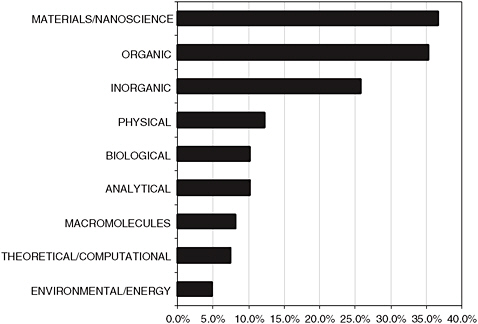
FIGURE 3-16 Distribution of top 100 hot papers among areas of chemistry, 2004-2006.
NOTE: Percentages do not total 100 because some papers were assigned to multiple areas.
SOURCE: Thomson ISI Essential Science Indicators.
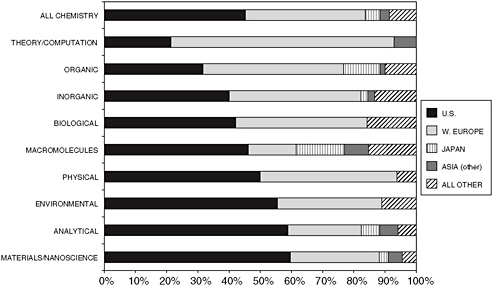
FIGURE 3-17 Country/region distribution of hot papers for the areas of chemistry. (List of hot papers by subarea given in Appendix C, Table C-2.)
SOURCE: Thomson ISI Essential Science Indicators.
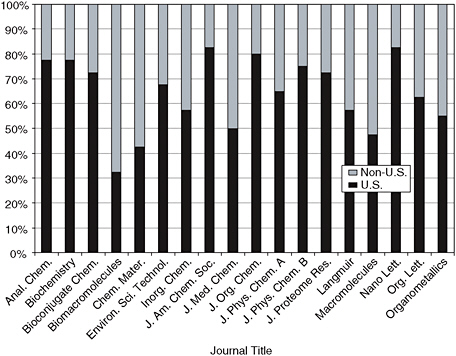
FIGURE 3-18 Percentage U.S. and non-U.S. most accessed ACS articles, 2004-2005.
SOURCE: ACS publications website (pubs.acs.org).
OTHER MEASURES OF LEADERSHIP
In addition to the extensive look at journal articles published and cited, the panel assessed leadership in chemistry research through the virtual congress exercise, international congresses, and international prizes.
Strong U.S. Representation in Virtual World Congresses
In an effort to determine the leading chemists in the world, the panel called on an international group of chemists for their qualitative assessment of the subareas of chemistry. This exercise is referred to as the “virtual world congress.”
To carry out the exercise, the field of chemistry was divided into 11 major areas. Each area was further subdivided into two to seven subareas. The panel then identified 8 to 10 respected leaders throughout the world in each subarea. These leaders were asked to imagine that they were to organize an international congress symposium on the subarea topic; then, regardless of travel costs, visa restrictions, or the opinions of their peers, they were asked who would be the 10 to 20 “best of the best” researchers in their subfields who must participate in the imaginary session.
The virtual congress data were used to characterize the relative position of the United States in each of the subfields. The panel considered the following criteria to assess research leadership as determined by the virtual world congresses:
-
Greater than 75 percent: the strong leader
-
Greater than 50 percent: the leader
-
Greater than 30 percent: among the leaders
-
Less than 30 percent: lagging behind the leaders
The strong predominance of U.S. speakers (50 to 70 percent) selected for the virtual world congresses shows strong U.S. leadership in chemistry (see Figure 3-19). Typically, when the organizer of the virtual world congress was a U.S. chemist, about 15 percent more of the speakers were from the United States than when the organizer was from elsewhere. These data will be discussed in more detail in the area assessment later in this chapter.
Large Percentage of U.S. Speakers at International Congresses
In another attempt to identify the world’s leading chemists, the panel examined the lists of invited speakers at real (not imaginary) international chemistry meetings. The percentage of speakers from different countries
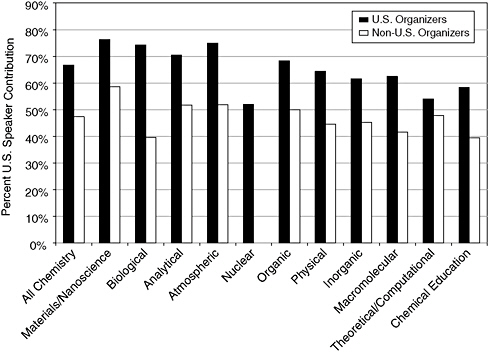
FIGURE 3-19 Percentage of U.S. speakers proposed by U.S. and non-U.S Virtual World Congress organizers.
was used to assess each nation’s strength in chemistry research. As expected, the results were skewed toward a concentration of speakers from the same geographic area where the conference was held.
The panel looked at 46 international congresses that took place between 2004 and 2006. All 28 of the U.S. congresses and five of the non-U.S. congresses were Gordon Research Conferences (GRCs), which strive to “provide an international forum.” The panel chose to concentrate on GRCs rather than other symposia because GRCs are small selective meetings that are highly regarded internationally for which speaker data were readily available. For the 28 U.S.-based GRCs, 70 percent of the speakers were from the United States (see Figure 3-20). For the 18 non-U.S. congresses, while only 30 percent of the speakers were from the United States, the U.S. contingent was larger than that of any other nation at these meetings.5 It is evident from the speaker data that although they are international, GRCs are biased in favor of U.S. researchers, which the panel took into consideration.
|
5 |
Appendix D lists the international congresses considered by the panel and the relative frequency of U.S. and non-U.S. chemists as invited plenary speakers. |
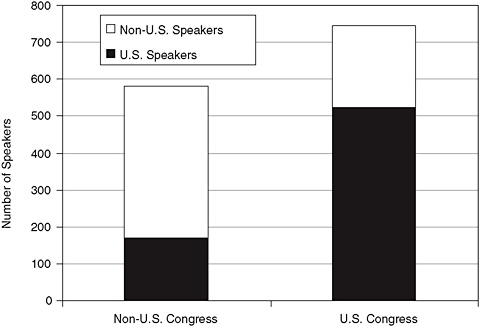
FIGURE 3-20 Number of invited speakers based on country affiliation and location of international congresses.
Gordon conference speakers are chosen from the leaders in a given subarea, and counting them should be an excellent benchmark of a country’s status in the international arena. Sixty-eight percent of the 890 speakers at the 34 GRCs were from the United States. The composition of the five non-U.S. GRCs analyzed by the panel is shown in Figure 3-21.
Success of U.S. Chemists in Winning International Prizes
A nation’s leadership in a scientific area is reflected in the number of its scientists who win major international prizes (see Tables 3-4 and 3-5). However, since prizes are sometimes awarded long after the recognized discovery, they are less informative about the current state of a nation’s science. Between 2000 and 2006, 11 of 18 Nobel laureates in chemistry were U.S. scientists.
ASSESSMENT OF LEADERSHIP IN SPECIALIZED AREAS OF CHEMISTRY
This section looks more closely at the different areas and subareas in which chemists classify their research. These areas were chosen by the panel
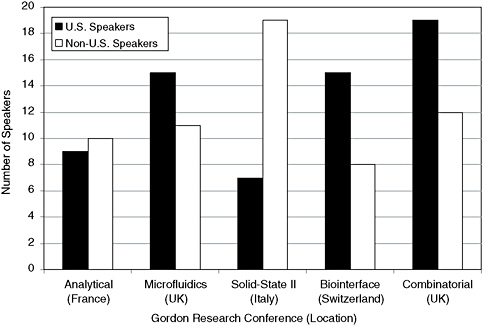
FIGURE 3-21 U.S. and non-U.S. participation as speakers at five chemistry GRCs held abroad.
SOURCE: National Research Council-generated tabulation of names listed on agendas on GRC website.
TABLE 3-4 2000-2006 Winners of Nobel Prize in Chemistry
|
Prize |
Laureate |
Citizenship |
Research Done in |
|
2000 |
Alan Heeger |
United States |
United States |
|
|
Alan MacDiarmid |
United States and New Zealand |
United States |
|
|
Hideki Shirakawa |
Japan |
Japan |
|
2001 |
William Knowles |
United States |
United States |
|
|
Ryoji Noyori |
Japan |
Japan |
|
|
K. Barry Sharpless |
United States |
United States |
|
2002 |
John Fenn |
United States |
United States |
|
|
Koichi Tanaka |
Japan |
Japan |
|
|
Kurt Wuthrich |
Switzerland |
Switzerland |
|
2003 |
Peter Agre (M.D.) |
United States |
United States |
|
|
Roderick MacKinnon (M.D.) |
United States |
United States |
|
2004 |
Irwin Rose |
United States |
United States |
|
|
Aaron Ciechanover |
Israel |
Israel |
|
|
Avram Hershko |
Israel |
Israel |
|
2005 |
Richard Schrock |
United States |
United States |
|
|
Yves Chauvin |
France |
France |
|
|
Robert Grubbs |
United States |
United States |
|
2006 |
Roger Kornberg |
United States |
United States |
TABLE 3-5 Other Major Science and Engineering Prizes Awarded to Chemists
|
Prize |
Total Awardees |
Total U.S. Awardees |
Chemistry Awardees |
U.S. Chemistry Awardees |
|
Wolf (Chemistry) |
6 |
4 |
4 |
4 |
|
Japan (2001-2006) |
17 |
4 |
5 |
1 |
|
Kyoto |
20 |
8 |
4 |
4 |
|
NOTES: The Wolf Prize is awarded by the Wolf Foundation in Israel (http://www.wolffund.org.il/cat.asp?id=15&cat_title=CHEMISTRY). Since 1978, five or six prizes have been awarded annually in the sciences. Prize fields are agriculture, chemistry, mathematics, medicine, and physics. The Japan Prize is awarded by the Science and Technology Foundation of Japan (http://www.japanprize.jp/prize/prize_e1.htm). This is awarded to people whose original and outstanding achievements in science and technology are recognized as having advanced the frontiers of knowledge and served the cause of peace and prosperity for mankind. Fields of study for the prize encompass all categories of science and technology. The Kyoto Prize is awarded by the Inamori Foundation, Japan (http://www.kyotoprize.org/ or http://www.inamori-f.or.jp/index_e.html), which is an international award to honor those who have contributed significantly to the scientific, cultural, and spiritual betterment of mankind. The prize is presented annually in each of the following three categories: advanced technology, basic sciences, and arts and philosophy. Laureates shall in principle be individuals (one person per category). |
||||
as representative of both the historic and future directions of the field of chemistry.6
The United States Is the Leader in Analytical Chemistry
Analytical chemistry is the science of measurement of chemical properties and chemical quantities. Analytical chemists determine the fundamentals of instrumental responses to chemical properties; invent instrumentation for molecular and atomic separation, characterization, and imaging; and develop a rigorous understanding of how to interpret experiments that characterize chemicals. Analytical chemistry interfaces strongly with other chemical, chemical engineering, biological, and physical sciences, through shared interests in the chemical structures and molecular compositions of complex systems, including nanodevices and living organisms. Analytical chemists’ tools and interpretation provide diagnoses of diseases, assure the purity of pharmaceutical products, obtain forensic information, investigate global warming, and describe the human genome.
Five specialty areas were examined to assess the current status of the U.S. contribution to analytical chemistry. These five were selected because
of current excitement, activity and importance and because they overlap across other fields of chemistry and science. They do not represent the complete breadth and vitality of analytical chemistry. Many of the other topics evaluated in this report overlap with analytical chemistry—for instance, nanoscience, computational chemistry, and spectroscopy.
Single-cell analysis is emerging as a field that will be critical to reaching a systems-level understanding of biological processes. Complete, preferably digital, information about the molecular states of individual cells is one aspect. Being able to observe even single molecules directly in context inside cells is a related goal. A further important aspect is the observation of interacting macromolecules in individual cells.
Sensors and detectors include the development and application of techniques and methods for sensing targeted chemicals or for broadband detection of many chemicals in vivo and in the environment.
Proteomics is a rapidly expanding field whose aim is to systematically study protein structure, function, interactions, and dynamics. Much effort is presently directed at the development of analytical strategies to analyze many proteins simultaneously. This developing technology is also influencing the design of critical medical studies and questions in biochemistry and bioorganic chemistry.
Molecular imaging includes mapping of specific chemicals and chemical properties across heterogeneous surfaces, such as lipids across cell surfaces, proteins atop tissue slices, and carbonyl grouping on carbon surfaces. Surface imaging includes exploration of topology and surface features in addition to chemical composition.
Microfluidics and miniaturization include the development of small and microscale devices to permit chemical measurements, with the objective of field portability or bedside use. Examples include Raman spectroscopy and mass spectrometry. The category also includes devices that employ small-scale fluidics to provide automated sample processing, chemical reactions, separation, and measurement in devices popularly called lab-on-a-chip.
Assessment
Analysis of the virtual congresses, highly cited papers, and the U.S. share of papers published in Analytical Chemistry (the leading journal for this area) as a whole, shows that the United States is the leader in analytical chemistry. The percentage of papers in Analytical Chemistry from non-U.S.
chemists averaged 48 percent over 2000-2005. U.S. authors contributed an average of 41 percent of the papers in the three leading proteomics journals. These percentages support the suggestion that the United States holds a lower position in proteomics and in fact is several years behind Europe in this 11-year-old field.
Among the hot papers analyzed, 10 percent were attributed to analytical chemistry (Table 3-3); 60 percent of these articles were U.S. authored, 25 percent were from Western Europe, 5 percent were from Japan, 5 percent were from “other” Asia, and 5 percent were from all other countries or regions. These data taken alone would place the U.S. as the leader in analytical chemistry. In terms of journal citations, contributions to highly cited articles from the area of analytical chemistry have grown over the years—from 37.5 percent for 1990-1994 and 48.8 percent for 1995-1999, to 49.3 percent for 2000-2006. Taken alone these data place the U.S. among the leaders in analytical chemistry. However, the U.S. contribution to the most cited articles in the ACS journal Analytical Chemistry has been declining, while Western Europe’s contribution has increased significantly. U.S. authors contributed 75 percent of the most accessed articles in Analytical Chemistry and 70 percent in the Journal of Proteomic Research.
Many organizers of virtual congresses in analytical chemistry further divided and defined the five subareas. In molecular and surface imaging, microfluidics and miniaturization, and sensors and detection, 63 to 66 percent of the speakers were U.S. scientists. In single-cell analysis, where only U.S. organizers responded, 76 percent of the speakers nominated were from the United States. In proteomics, where the majority of responding organizers were non-U.S., 47 percent of the speakers proposed were U.S. scientists. From these results it appears that U.S. scientists make up at least half of the leaders in these fields of analytical chemistry.
The combination of all the data from publications analyses and virtual congress results point to the U.S. being the leader in analytical chemistry.
The United States Is Among the Leaders in Atmospheric Chemistry
Atmospheric chemistry is an interdisciplinary field that deals with chemical composition, transformation, and transport in the atmosphere. Understanding chemical sources, their inputs, and their transport and transformation is a major goal of atmospheric chemistry. The three major subfields of atmospheric chemistryare: 1) field measurements, 2) modeling, and 3) laboratory studies. There is synergistic interplay between these three areas. An aim of the field measurements area is to measure the abundance of chemical pollutants and their sources in the atmosphere. Field studies also give a direct measure of the transport of chemical species throughout the atmosphere. The modeling area aims to understand the fate and trans-
port of pollutants. Modeling aims to provide a fundamental evaluation and test of our understanding of the underlying chemistry from laboratory studies to explain the chemical transformation and transport observed from field measurements. Models use fundamental information from laboratory chemical kinetic and mechanistic studies in all phases—gases, liquids, and solids—with photochemical transformation properties of chemical systems from laboratory studies to make predictions. Instruments to measure pollutant concentration and other characteristics are developed and tested in the laboratory and then deployed in the field. Laboratory studies use state-of-the-art tools from physical chemistry to provide accurate measurements of the chemical kinetics of reacting chemical entities and to develop a complete picture of the chemical transformation through reactive collisions and photochemistry.
To assess the current U.S. position in the field of atmospheric chemistry, the three areas of field measurement, modeling, and laboratory studies were examined.
Assessment
The United States is the leader in atmospheric chemistry as shown by the virtual congresses, which had 60 percent participants from the United States, where 75 percent of the participants from U.S. organizers were from the United States, and 52 percent of speakers from non-U.S. organizers were from the United States. The virtual congresses also showed a balance in representation from researchers involved in field measurement, laboratory, and modeling. From the virtual congress data, the laboratory measurement groups in the United States are the leaders in atmospheric chemistry. Over 80 percent of the participants from both U.S. and non-U.S. organizers were from the United States. Strong competition in the field measurement and modeling areas is coming from Germany and the United Kingdom. The virtual congress data taken alone place the U.S. as the leader in atmospheric chemistry.
In one of the premier journals that publish field measurement, modeling, and laboratory studies, the Journal of Geophysical Research, over the time period from 1997 to 2005, 63 percent of the papers were contributions from U.S. authors. Of the non-U.S.-authored contributions, 84 percent were from Europeans. During the time period of 1996-2006, U.S. authors contributed 45 percent of the 350 most highly cited articles to the Journal of Geophysical Research. Outside the European Union, China showed a steady rate of growth in contribution to the Journal of Geophysical Research. Two specialized journals in the field, the Journal of Atmospheric Chemistry and Atmospheric Environment, which publish a proportionally larger number of modeling and field measurement studies, indicate that the
strongest competition is coming from Germany. For example, in the Journal of Atmospheric Chemistry the U.S. contribution in 2000 was 32 percent and that from Germany was 30 percent. In 2005, the U.S. contribution was 29 percent and that from Germany was 22 percent. Furthermore, the U.S. author contribution accounted for 17 percent of the 283 most highly cited articles from 1996 to 2006 in the Journal of Atmospheric Chemistry. Other active countries—France, the United Kingdom, and Japan—accounted for the difference. Other important journals where many laboratory studies are often published are the Journal of Physical Chemistry and Chemical Physics. Atmospheric chemistry contributions are highly consolidated with the physical chemistry experimental contributions, and no reliable information or inference could be obtained. The highly cited articles and other publication analysis places the U.S. among the leaders or lagging behind the leaders in the area of atmospheric chemistry.
The United States Is the Leader in Biological Chemistry
Biological chemistry involves the use of chemistry to develop a better understanding of biological processes. To assess the current status of the U.S. contribution to biological chemistry, five subareas were examined:
Chemical and structural biology is concerned with the development of chemical and biological approaches to solving problems in living systems, which usually involve determination of the three-dimensional structures of biomolecules, mainly proteins and nucleic acids, and their complexes with ligands, receptors, drugs, or other interacting components. The structural information provides a basis for understanding the mechanism and function of the biomolecules and for molecular design.
Biocatalysis is the study of biological catalysts with regard to their kinetics, mechanisms, specificity, and application in synthesis and analysis. In addition to the traditional study of mechanistic enzymology, biocatalysis is concerned with the use of recombinant DNA technology, site-specific mutagenesis, directed evolution, pathway engineering, substrate design, and structure-based approaches as tools for the development of novel catalysts and reactions.
Nucleic acids and functional genomics cover the chemistry and biology of gene-related substances. Current subjects of study include genomic sequencing, genotyping, and genomic profiling with arrays; DNA damage; and the functional study of genes, including, for example, the study of transcriptional and translational processes that translate into cellular function at the protein level.
Signaling pathways is a subarea of biological chemistry that is concerned with the study of molecular interactions and/or reactions in sequence in the living system that triggers a functional event.
In vivo molecular imaging refers to the spatial and/or temporal visualization of different cellular elements and biochemical reactions in a living organism using different imaging methodologies and labeled tracers with high molecular specificity. Tracers are labeled with radioisotopes for nuclear imaging, (with positron emission tomography (PET), microPET and single photon emission computed tomography), fluorescent probes for optical imaging or paramagnetic ions for nuclear magnetic resonance (NMR) imaging.
Assessment
The United States is the leader in biological chemistry, especially with regard to innovative research in the areas of chemical and structural biology, signaling pathways, nucleic acids, and functional genomics, and is among the leaders in biocatalysis and in vivo molecular imaging.
In more specialized journals, U.S. authors contributed 60 percent to Biochemistry, 56 percent to Protein Science, 47 percent to Bioconjugate Chemistry, 45 percent to Proteins, 42 percent to Nature Biotechnology, 59 percent to the Journal of Biological Chemistry, 22 percent to ChemBioChem, 65 percent to Nature Structure & Molecular Biology, 45 percent to the Journal of Molecular Biology, and 62 percent to Chemistry and Biology. Taken alone, these data place the U.S. as the leader or among the leaders in biological chemistry.
Of the highly cited journal articles in biological chemistry, 55.9 percent were authored by U.S. scientists during 1990-1994, 57.4 percent during 1995-1999, and 54.4 percent during 2000-2006. The journal Biochemistry had 78 percent of its most accessed articles authored in the United States (2004-2005).
The virtual congresses in chemical and structural biology and nucleic acids and functional genomics had very high representation from U.S. participants, with 75 and 83 percent, respectively, of selected speakers from the United States. The virtual congresses in signaling pathways and in vivo imaging also had high representation from the United States, with 69 and 63 percent respectively. The subarea of biocatalysis had 49 percent of selected speakers from the United States. The virtual congresses also showed strength in chemical and structural biology for the United Kingdom and Germany; strength in nucleic acids and functional genomics for the Netherlands; and great strength in biocatalysis for Japan, the United Kingdom, and the Netherlands.
When all the data for the area of biological chemistry are evaluated in concert, the results point to the U.S. as the leader in biological chemistry.
The United States Is the Leader in Chemistry Education
Chemistry education is a relatively new research area at the crossroads between chemistry and science education. The questions investigated often develop from concerns raised by teaching chemists, and the research tools come from the science education community. Chemical educators apply theories of teaching or learning to study the interaction between how students learn chemistry and how the subject is taught. A new paradigm where teaching innovations are introduced based on research is replacing the reverse process. Many of the papers in chemistry education still follow the old paradigm: evaluation of one teaching method versus another with little or no reference to the underlying learning theory or presentation of isolated bits of information on the teaching/learning process. Chemistry education researchers are hampered by their relative isolation since few universities have more than one chemistry educator.
The United States provides significant funding for education efforts in chemistry, but little funding is directed specifically at research in chemistry education. For example, NSF’s Integrative Graduate Education and Research Traineeship Program involves large numbers of research chemists in education projects but does not focus on the research aspect of chemistry education.
Assessment
Publications by U.S. authors accounted for 64 percent of content for the Journal of Chemical Education, with the rest of papers being contributed mainly from Canada, the United Kingdom, and Spain. Other countries showing particular leadership and strength in this area are Australia, the Netherlands, Germany, and the United Kingdom. U.S. chemists contributed 74 percent of the highly cited articles in chemistry education between 1995 and 1999 and 68 percent between 2000 and 2006. These results taken alone place the U.S as the leader in chemical education. In the United States there are two chemistry education programs that have a concentration of researchers. These two programs (Purdue University and the University of Wisconsin) showed high visibility in the virtual congresses organized by non-U.S. chemical educators.
The virtual congress data show a 49 percent participation by U.S. speakers. When combined, the publications analysis and the virtual congress data place the U.S. as the leader in chemical education.
The United States Is the Leader in Inorganic Chemistry
Inorganic chemistry deals with the chemistry of the elements of the entire Periodic Table. This includes synthesis, characterization, and theoretical studies. The field experienced a renaissance beginning in the 1950s, driven by appreciation of the diverse modes of reactivity and bonding as well as numerous industrial applications spanning many fields. To assess current U.S. vitality in the field of inorganic chemistry, four representative subareas of inorganic chemistry were analyzed:
Organometallic chemistry and homogeneous catalysis deal with the synthesis and transformations of compounds, or of transformations mediated by compounds, having metal-carbon and related metal-element bonds. Organometallic chemists carry out research on the synthesis, reactivity, and physical properties of organometallic compounds with a focus on unusual bonding situations, unusual transformations and their mechanisms, and theory to understand these phenomena. Homogeneous catalysis specialists strive to use these concepts to effect rapid and selective catalytic transformations. Organometallic compounds play an important role in both stoichiometric and catalytic organic synthesis, including routes to fine chemicals, pharmaceuticals, flavors and fragrances, and myriad industrial chemicals. Other important uses of organometallic compounds are as precursors of diverse electronic and optoelectronic materials. This includes the synthesis of compounds important in the production of computer logic and display components, solid state lasers, and cell phone components, primarily via chemical vapor deposition film growth processes.
Main group chemistry focuses on elements other than carbon and transition metals. While much attention is paid to unusual bonding situations, unusual reactivity, and the theory to understand these phenomena, the importance of main group chemistry also lies in its application to other areas. Main group compounds (frequently organometallic compounds) play a major role in synthetic organic chemistry, with examples being boron (B) for hydroboration, catalytic Suzuki coupling, lithium (Li) and magnesium (Mg) as alkylating reagents, aluminum (Al) for reductions, silicon (Si) for protecting groups, tin (Sn) for catalytic coupling reactions, and sulfur (S) and selenium (Se) for selective oxidations.
Another major application for main group chemistry is in solid state chemistry relevant to electronic and optoelectronic materials. Ultrapure Si is the basis of almost all computer logic and display components, and the production and processing of these materials rely heavily on highly optimized Si and in some cases, germanium (Ge), reaction chemistry. Likewise, the III-V materials produced for solid state lasers and cell phone components rely
heavily on the ability to manipulate gallium (Ga), indium (In), arsenic (As), and antimony (Sb) compounds in chemical vapor deposition processes.
In the materials as well as biomaterials areas, Si and Al compounds are produced on a large scale for catalyst supports, solid phases for chromatographic and gas separations, sorbants, silicone fluids and resins, silicones for artificial organs/veins, and so forth. Fluorocarbons find use in high-performance polymers such as Teflon and Nafion. In the biomedical area, B compounds are used for neutron-capture therapy, barium (Ba) compounds for X-ray imaging, lanthanide compounds for magnetic resonance imaging, and fluorinated organic molecules in numerous pharmaceuticals.
Bioinorganic chemistry deals primarily with the role of metal ions in biology. Today, the great bulk of traditional coordination chemistry research has merged with bioinorganic chemistry, and this area spans the gamut from understanding the roles of metal ions in metalloenzyme function to new metal-containing drugs and imaging agents. Contemporary bioinorganic research involves both the synthesis and understanding of “model compounds” that serve as instructive functional or spectroscopic facsimiles of metalloenzyme active sites to detailed studies of wild and modified biological systems. Key questions concern how Nature has modified metal ion environments to allow enzymatic functions often difficult or impossible to achieve in simple synthetic complexes, such as molecular oxygen binding and activation, reduction and functionalization of molecular nitrogen, selective hydrocarbon functionalization, photosynthesis, and protein shape control. Beyond metalloenzymes, metal-based pharmaceuticals play an important role as antitumor agents and other drugs. Bioinorganic chemists also study new types of imaging agents both for diagnostics and to understand drug action mechanisms; examples include lanthanides (MRI) and radiopharmaceuticals such as technetium (Tc).
Solid state chemistry includes the synthesis, characterization, and application of extended oxide, chalcogenide, halide, carbide, nitride, and other solids. The elemental constituents in solid state chemistry span the entire Periodic Table, and the research focus is likewise very broad. Solid state chemists study new synthetic methods (many exotic by molecular chemistry standards), diverse characterization methods (many at the frontier of chemistry and solid state physics), theory appropriate for extended solids, and the applications of solid state compounds. The latter is vast, ranging from cement and ceramics for fabrication of large, high-strength object, to materials for magnets, data storage, lasers, optical detectors, photovoltaic cells, catalysts, supports for separations, turbines, catalysts, artificial bones, conductors, semiconductors, superconductors, batteries, X-ray detectors, emissive displays, cutting tools, and coatings of all sorts.
Assessment
The virtual congresses in organometallic chemistry and homogeneous catalysis had 50 percent of the chosen speakers from the United States. The virtual congress data also showed strength in organometallic chemistry and homogeneous catalysis for Germany, Japan, Canada, the Netherlands, and Spain. In this area, the United States has strong competition in Europe and Asia. For example, recent Nobel prizes have been given jointly to investigators from the United States and Japan and from the United States and France. U.S. authors contributed 26 percent of the papers to the journal Organometallics and 55 percent of the 40 most accessed papers in 2004-2005 (major international contributions came from Italy, the United Kingdom, Germany, Spain, and Japan).
The United States is among the leaders in main group chemistry. In the virtual congress assessment, only 39 percent of the chosen speakers were U.S. chemists; Germany, Japan, the United Kingdom, Canada, and France showed strength. While no ACS journal is devoted exclusively to main group chemistry, U.S. contributions to Inorganic Chemistry and Organometallics (which have significant main group representations) are 35 percent and 26 percent, respectively.
The United States is clearly the leader in bioinorganic chemistry. In the virtual congress assessment, 71 percent of the chosen speakers were from the United States; speakers from Germany, Japan, the United Kingdom, Italy, and Spain also were also prominent. While no ACS journal is devoted exclusively to bioinorganic chemistry, Inorganic Chemistry publishes many bioinorganic papers and U.S. authors accounted for 35 percent of the papers in Inorganic Chemistry and for 60 percent of the papers in Biochemistry. U.S. bioinorganic chemistry is successful because it is well supported by National Institutes of Health funding and because U.S. chemists perceive that it deals with timely and important problems. Consequently, bioinorganic chemistry attracts talented faculty and students and enjoys excellent support in terms of facilities, instrumentation, and training grants.
The United States is the leader in solid state chemistry. U.S. speakers have 57 percent representation at both the virtual congresses and specialized Gordon Research Conferences. The leaders, particularly in materials synthesis, are France, Germany, the United Kingdom, and Japan; U.S. students often choose to pursue postdoctoral studies in materials synthesis in these countries. High-pressure crystal growth facilities, which are critical for research in this subfield, are lacking in the United States, but many exist in Japan and Russia.
The United States Is the Leader or Among the Leaders in Macromolecular Chemistry
Macromolecular chemistry (a more modern and inclusive name than polymer chemistry) involves the synthesis and physical characterization of high molecular weight (> 2,000 g/mol) organic or inorganic materials having well-defined repeating units. Early research in macromolecular chemistry originated from industrial and military laboratories dealing with synthetic plastics. However, this discipline has emerged as an interdisciplinary field ranging from petroleum-based macromolecules to biological macromolecules, including nucleic acids, proteins, and polysaccharides. Macromolecular chemistry is an enabling science that impacts diverse technologies, including energy and sustainability, biomedicine, electronics, and structural materials.
The impact of macromolecular chemistry on our nation’s commercial, military, and scientific competitiveness is extraordinary. Macromolecular chemistry provides materials for automobiles and diverse consumer applications, including drug delivery and biomaterials. Macromolecules are used in clothing fibers, computers, semiconductor imaging, cosmetics, structural films and sheets, food and beverage packaging, adhesives, artificial organs, tissue scaffolds, surgical sutures, and automobile parts. During the past decade, macromolecules have played critical roles in the development of new technologies such as nanotechnology, biomedical devices, alternative energy technologies, photovoltaic devices, membranes, sensors, fuel cell components, and smart and self-healing coatings.
Supramolecular chemistry is an emerging subarea that focuses on assemblies of covalent molecules held together by noncovalent bonding interactions. Supramolecular chemistry utilizes far weaker and reversible noncovalent interactions, such as hydrogen bonding, metal coordination, hydrophobic forces, and electrostatic effects to assemble molecules into multimolecular complexes. Important concepts that have been demonstrated by supramolecular chemistry include host-guest chemistry, self-assembly, and molecular recognition. Supramolecular chemistry is often deeply integrated within the macromolecular chemistry field as researchers are now using tailored intermolecular interactions for the construction of a repeating unit.
To assess the current status of the U.S. contribution to macromolecular chemistry, four representative subareas were examined:
Macromolecular synthesis involves the design of synthetic methodology for the formation of macromolecular architecture, including controlled molecular weight and molecular weight distribution, stereochemistry, topology (linear, branched, and cross-linked), block and graft copolymers, and
hyperbranched/dendritic structures. Biomacromolecular chemistry deals with bioderived monomers, macromolecular interactions with biological structures, biomaterials, biodegradation, drug/gene delivery, macromolecular interactions at the cellular level, and in vivo applications. There is a synergy between advances in macromolecular synthesis and advances in structural characterization by nuclear magnetic resonance and in situ Fourier transform infrared FTIR spectroscopy, size exclusion chromatography, and mass spectrometry.
Supramolecular chemistry uses tailored noncovalent bonding for the rational design of macromolecular architectures. Multihydrogen bonding, self-assembly, electrostatic interactions, amphiphilic organization, and metal-ligand interactions are utilized for the formation of potentially reversible macromolecular architecture. An emerging area involves the integration of biological structures that inspire sophisticated molecular recognition events with synthetic scaffolds.
Physical characterization of macromolecular systems strives to determine chemical structure/property relationships. This subfield includes study of thermomechanical performance; viscoelastic properties; surface properties, adhesion science; thermal transitions; morphological analysis, including semicrystalline, amorphous, liquid-crystalline, and microphase-separated structures. Structural analysis employs electron microscopy, confocal microscopy, optical microscopy, x-ray photoelectron spectroscopy, atomic force microscopy, and x-ray and neutron scattering of macromolecular compositions.
Rheology (the study of deformation and flow of materials) provides the fundamental understanding needed to develop technologies for processing macromolecular materials to fabricate coatings, films, molded objects, and fibers. Research efforts strive to correlate macromolecular structure with viscosity (melt and solution) and modulus (stiffness) as a function of frequency and temperature. Polymer physics and molecular modeling of macromolecular structure and diffusion are fundamental to advances in this field.
Assessment
The United States is the leader in most areas of macromolecular chemistry, as shown by virtual congress data. The virtual congresses in macromolecular synthesis had a very high, 64 percent, representation from U.S. speakers. Those on the physical characterization of macromolecules also showed a very high 68 percent proportion of U.S. speakers (this number
may be inflated since only U.S. organizers responded). The virtual congresses in processing and rheology had a strong 50 percent representation from U.S. speakers. The supramolecular chemistry congresses had only 39 percent U.S. speakers. The United States was certainly not dominant in this important emerging field and intense competition from Europe was evident.
Analysis of hot papers (May-June 2006) showed that macromolecular chemistry accounted for 8 percent in chemistry and that U.S. chemists authored 46 percent of these macromolecular chemistry papers. The United States showed leadership in the areas of macromolecular synthesis and physical characterization and solid state structure with 75 percent of the hot papers. None of the hot papers in supramolecular chemistry came from U.S. authors; Western Europe showed leadership in this area with 40 percent of the hot papers.
Analysis of Thomson ISI data on the most highly cited papers in macromolecular chemistry journals showed a strong but declining contribution from U.S. authors, who accounted for 46 percent of the most highly cited papers from 1990 to 1994 and 35 percent from 2000 to 2006. International competition from Japan, Europe and China appears to be rising.
Macromolecules research accounted for 8.2 percent of all hot papers in chemistry from 2004 to 2006. Of these papers, 46.2 percent were contributed by the United States, 15.4 percent byWestern Europe, 15.4 percent by Japan, 7.7 percent by Asia (other), and 15.4 percent by all other. Only one-third of the most accessed ACS articles from the journal Biomacromolecules were contributed by U.S. scientists. In the journal Macromolecules, 48 percent of the most accessed ACS articles were contributed by U.S. scientists.
The leadership of U.S. macromolecular chemists was also demonstrated by their strong overall contributions (33 percent) to the ACS journal Macromolecules. This journal is traditionally more oriented toward physical property measurements and less toward macromolecular synthesis. It is important to note that U.S. authorship in Macromolecules was down significantly from 51 percent from 1990 to 94, showing a significant increase in international competition, although the United States remains a leader. Authorship of papers in Macromolecules indicates rising competition from Germany, Japan, and more recently China (7 percent of publications and 20 percent of the most accessed articles from 2004-2005). There is significant focus on macromolecular materials and electronic materials in Asia and Japan, where chemists are looking for the performance of macromolecules to enable new technologies.
Langmuir, the ACS journal covering the areas of colloids, surfaces, and interfaces, also showed a strong contribution from U.S. authors (35 percent of all papers and 68 percent of the 40 most accessed papers for 2004-
2005); authors from Japan, Germany, the United Kingdom, and China also were major contributors. In the ACS journal Chemistry of Materials, U.S. authors were the leading contributors (30 percent of all papers and 40 percent of the most accessed papers for 2004-2005); authors from Japan, Germany, France, and China were also major contributors. U.S. authorship in the relatively new ACS journal Biomacromolecules, with editorial offices based in Europe, was 25 percent of all papers and 23 percent of the 40 most accessed papers for 2004-2005). U.S. authorship in the United Kingdom journal Polymer remained stable at 20 to 25 percent over the past decade, and 50 percent of the 30 most cited papers in Polymer were from U.S. authors.
Based on the overall publications record in top journals and authorship of highly cited and hot papers, combined with the virtual congress results, the U.S. is the leader or is among the leaders in macromolecular chemistry.
The United States Is the Leader in Materials Chemistry and Nanoscience
The field of materials chemistry and nanoscience builds the bridge between fundamental chemistry and applied science and technology. The synthesis of materials, the improvement of their physicochemical properties, the development of reliable processing and fabrication routes leading to miniaturization, and the design of “smart” structures and devices are pivotal to industrial growth and a competitive economy.
The expertise required to tackle these diverse materials problems is largely provided by chemists. However, due to the highly multidisciplinary nature of the field, researchers work across a variety of disciplines (chemistry, physics, engineering, materials science, biology), and synergistic interactions among scientists from different disciplines are often required to create productive environments for interdisciplinary research collaboration. Even the chemistry field, there is a strong overlap between materials chemistry and physical, polymer, inorganic, and computational chemistry. It is noteworthy that the field of materials chemistry and nanoscience is the fastest developing field in chemistry: While the total number of articles in chemistry steadily increased by about 25 percent every five years, the number of papers in nanochemistry increased exponentially—by 150 percent from 1995 to 2000 and by another 250 percent from 2000 to 2005.
To assess the current status of the U.S. contribution to modern materials and nanochemistry, six representative subareas were identified:
Self-assembly science addresses the chemical, biochemical, and physical aspects of the ability of molecules, particles, and systems to assemble into higher-order structures. The subfield is very diverse, with “hot” topics
including self-assembled monolayers and multilayers, hierarchical assembly, assembly of nanoparticles, liquid crystals, supramolecular assembly, surfactant-driven assembly, assembly of biomolecules (DNA, proteins, etc.), polymer assembly, control of the assembly of dissimilar materials into hybrid structures, multicomponent assembly, synthetic membranes and vesicles, and computer modeling of self-assembled systems.
Nanocrystal and cluster science is the study of the chemical synthesis and physical properties of individual nanocrystals and nanotubes. It seeks to understand the evolution of molecular properties into solid state properties with increasing size. Methods include so-called bottom-up chemical synthesis of nanocrystals, nanowires, and very large species, as well as physical molecular beam approaches. Advanced physical characterization of single nano-objects by local probe methods and optics is critical here. The area is intrinsically interdisciplinary at the junction of physics, chemistry, and materials science. Outstanding chemical research in nanocrystal science is often found in a wide variety of science and engineering departments.
Nanomaterials: energy and applications: As nanocrystals and nanotubes are better understood, it becomes possible to rationally design nanostructured materials for specific purposes. This area includes both chemical synthesis and physical properties of nanostructured materials incorporating fullerenes, organic conductive polymers, and inorganic nanostructures. A central goal is composite materials for solar energy utilization—new types of solar cells.
Biomaterials/bio-inspired materials synthesis: The general objective of this new, and rapidly developing subfield is to search for smart biological solutions in the synthesis, assembly, and integration of complex materials systems and to apply this knowledge to develop biomimetic synthetic strategies with the ultimate goal of creating new materials of technical importance. The hot topics in the subfield encompass the assessment of materials properties (optical, electronic, mechanical, nanostructural) of exquisite biogenic structures; the characterization of biomacromolecules that control their formation; biomineralization mechanisms; the study of templating at the organic/inorganic interfaces; bottom-up synthetic strategies; harnessing the potential of biomolecules or organisms for the synthesis and assembly of artificial materials with advanced properties; the use of biological strategies in a different environment to create new materials but without biological fragility; and “smart,” responsive materials.
Bionano is an emerging interdisciplinary area that studies biological and hybrid biological/synthetic nanostructures. Chemical aspects of this
subfield include the synthesis and extraction of bionanocomponents; the assembly/bonding of biological nanostructures without loss of functionality; the integration and linking of biologically derived nanostructures (e.g., proteins, lipids, nucleic acids, carbohydrates) with any physically or chemicallynanofabricated components (e.g., carbon nanotubes, nanolithographed parts, fluorophores), to introduce fields, information transduction, or other functionality; the study of the physicochemical properties of hybrid bionanostructures with tailored interactions and functionality; and the development of computational approaches to predict and rationally design various functional bionanostructures.
Tissue engineering/biocompatibility is a highly multidisciplinary area that represents the confluence of three quite different domains—clinical medicine, engineering, and science—addressing the development of materials that restore, maintain, or improve tissue function. Chemical and biochemical research plays an increasingly important role in this area. Critical topics include chemical modification of natural materials for use in medicine, synthesis of artificial implant materials for bone repair and artificial organs, development of biocompatible and biodegradable polymeric and ceramic materials, and creating biocompatible surface chemistries for integrating synthetic materials into living tissue. There is a strong overlap between this subfield and polymer chemistry, ceramics, and surface chemistry.
The materials aspects of organic electronics, polymers, and solid state chemistry are described in the physical chemistry, macromolecular chemistry, and inorganic chemistry fields, respectively.
Assessment
The United States is the leader in materials chemistry and nanoscience in general. Its position varies, however, within different subareas, ranging from strong leadership to being among the leaders in specific subfields.
The United States has a very strong, perhaps even dominant position in nanocrystal and cluster science, as shown by virtual congress results: U.S. congress organizers had 75 percent U.S. speakers, and non-U.S. organizers had 50 percent U.S. speakers. The United States is the strong leader in the subfields of bionano and tissue engineering/biocompatibility, with very high (about 80 percent) representation from U.S. virtual speakers proposed by both U.S. and non-U.S. virtual congress organizers. The United States is the leader but not the dominant force in the subfields of self-assembly science and biomaterials/bio-inspired materials synthesis: U.S. congress organizers had 78 and 60 percent of U.S. speakers for the two subfields, respectively, while non-
U.S. organizers had 48 and 47 percent of U.S. speakers. When taken alone, the virtual congress data suggest that the U.S. is the leader in nanoscience.
The virtual congress data also revealed strong competition in self-assembly science from Europe (particularly from France, due to 1987 Nobel Prize laureate Jean-Marie Lehn and researchers trained in his group), Israel, and Japan. In biomaterials/bio-inspired materials synthesis, other countries that showed great strength were Israel, Germany, and the United Kingdom. There are significant research efforts in bionano in Europe (Switzerland, the United Kingdom, and Germany, in particular). In tissue engineering/biocompatibility there is competition from Switzerland, Japan, and Canada.
U.S. leadership is also demonstrated by contributions to the top peer-reviewed journals in materials chemistry and nanoscience. The new ACS journal Nano Letters presently has the highest impact factor of all ACS journals. It draws papers from a wide variety of academic departments and from strong overseas groups. The strong position of U.S. chemistry in the nanoscience area is shown by the U.S. scientists’ contribution of 66 percent of the papers and 82.5 percent of most accessed articles in Nano Letters. The contribution of U.S. authors was 43, 38, 32, 35, and 30 percent in Nature Materials, Advanced Materials, Advanced Functional Materials, Langmuir, and Chemistry of Materials, respectively. U.S. representation in the top 40 most accessed articles published in 2004-2005 in Langmuir and Chemistry of Materials was 50 percent in each journal. In materials chemistry, U.S. scientists contributed 41 percent of the most highly-cited articles from 2000 to 2006. Materials/nanoscience is the largest hot area in chemistry, accounting for 37 percent of all the hot articles 2004 to 2006. U.S. authors contributed 60 percent of the hot articles, and Western European authors contributed 28 percent. Based on the total authorship of most cited and hot papers, the U.S. is the leader in the field of nanoscience.
The leading position of the United States in materials chemistry and nanoscience was recognized by the Nobel Prize given to Richard Smalley and Robert Curl and by the Kyoto Prize awarded to George Whitesides.
The extreme multidisciplinary aspect of nanoscience is an ingredient of the U.S. success. U.S. academic training is typically broader than European and Japanese training in chemistry, and specialization occurs later in U.S. training. U.S. researchers are more able to assimilate and apply basic knowledge from different academic areas. Another reason for the leadership position is the strong new funding in nanoscience from the federal government.
The United States Is Among or Lagging Behind the Leaders in Nuclear and Radiochemistry
Nuclear and radiochemistry deals with radioactive substances—from fundamental studies of atomic nuclei and chemical properties of radioactive elements to practical applications of radioactivity and nuclear technology.
Nuclear and radiochemistry includes accelerator/reactor chemistry for isotope production, nuclear structure, neutrino chemistry, nuclear forensics, and archeometery. Understanding of nuclear and radiochemistry underlies the availability of adequate supplies as well as proper and safe use of radioactivity for energy production or radiomedicine. Twenty percent of electric power in the United States is supplied by nuclear reactors. It is possible that construction of new reactors in the United States will resume within the next decade. Similarly, the use of radionuclides in medicine, research, and industry is predicted to increase.
In assessing the current status of the U.S. contribution to nuclear and radiochemistry, several subareas were considered:
Basic nuclear science includes the synthesis of radionuclides, production of new elements, generation of radioactive and exotic nuclear beams, determination of nuclear properties, and applications of nuclear spectroscopy.
The subarea of nuclear energy production and nuclear waste concerns include studies of fuel cycles for Gen IV and Post Gen IV reactors, environmental studies of radioactive wastes, studies of the effects of radiation on fuel materials and wastes, and transmutation of radioactive waste products to reduce their lifetimes.
Environmental behavior of actinides includes studies of actinide interactions related to geochemistry; actinide interactions with microbes; and actinide redox reactions, speciation, and complexation.
Nuclear forensics involves using nuclear signatures to define the origin of radioactive materials, stable isotope signatures to determine geolocation, and conventional forensic information (fingerprints and fibers) from radiological samples.
Nuclear neutrino research includes neutrino experiments such as SNO, Super-Kamiokande, KamLAND, SAGE, and double-beta decay and theory of neutrino oscillations.
Nuclear isotope production involves policy studies of facilities for research and development of isotope production, radiochemistry education, and the role of national laboratories in isotope R&D.
Assessment
The United States has been recognized as a leader in nuclear and radiochemistry since the end of World War II. However, this leadership is eroding. Most of the research in nuclear and radiochemistry in the United
States is carried out at national laboratories. The number of U.S. chemistry departments offering a specialization in nuclear chemistry has decreased continuously over the past 30 years. There has been a corresponding sharp decline in the numbers of Ph.D.s in nuclear and radiochemistry (23 U.S. Ph.D.s from 1970 to 1980 versus 12 Ph.D.s from 1990 to 2000). According to the 2005 ACS Directory of Graduate Research, only a dozen departments still have a program in nuclear chemistry and these typically have one or two active faculty members.
The virtual congresses in nuclear chemistry were conducted a bit differently because of the smaller number of researchers in this community. Six individuals, all from the United States and five from national laboratories, were asked to develop a virtual congress in a different specialty area of nuclear chemistry. While the organizers were asked to pick about 20 congress participants, they provided an average of only 13 each. This is in contrast to many of the other areas of chemistry examined in this study, where most organizers had difficulty limiting themselves to only 20 names. Based on 52 percent representation from U.S. participants in the nuclear chemistry virtual congresses, the United States is considered the leader in this area. Other countries with significant representation are Germany, Japan, and the United Kingdom.
Based on journal analysis, the United States is among or lagging behind the leaders. In 2005, 19 percent of articles in Radiochimica Acta, approximately 30 percent in the Journal of Radioanalytical Nuclear Chemistry, and 30 percent in Separation Science and Technology were from U.S. authors. Authors from Japan and Western Europe, particularly Germany, are major contributors to these journals. Examination of the most cited articles in the Journal of Radioanalytical Nuclear Chemistry shows that the United States and Japan were the two largest single-country contributors (each with 10-20 percent of the authors), but Western Europe made the strongest regional contribution. Authors from Western Europe also contributed the greatest number of most cited articles to Radiochimica Acta, followed by authors from the United States and Japan.
Although the results from the virtual congress exercise show that the U.S. nuclear and radio chemists are still highly regarded, the declining number of U.S. nuclear and radiochemists, and the analysis of journal publications, all point to the United States being among the leaders or lagging behind the leaders in nuclear and radiochemistry.
The United States Is Among the Leaders in Organic Chemistry
Organic chemistry deals with all aspects of the chemistry of carbon compounds. Since carbon compounds, including fats, sugars, proteins, and nucleic acids, are the building blocks of all living organisms, there is
a strong linkage between organic chemistry and the chemistry of life processes. Organic chemists design and synthesize drugs to improve human health, agricultural chemicals to safeguard the food supply, commodity chemicals for use as personal care products, and polymers for use as structural materials or fibers for clothing. Organic chemists design processes to convert petroleum, coal, and biomass to fuels for transportation and a myriad of materials that enhance our daily lives.
Because chemistry has become so multidisciplinary, there is strong overlap and synergy between organic chemistry and biochemistry, pharmaceutical sciences, macromolecular chemistry, materials chemistry, and inorganic chemistry. Organic chemists in turn rely on advances in analytical chemistry, physical chemistry, and computational chemistry.
To assess the current status of the U.S. contribution to organic chemistry, five representative subareas of organic chemistry were examined:
Synthetic organic chemistry involves developing efficient and selective new reactions and designing and implementing the synthesis of complex molecules, including those related to natural products.
Medicinal chemistry and drug discovery is a more applied but crucial subarea of organic chemistry. Medicinal chemists design and synthesize new organic compounds to test as drug candidates. They seek to understand and exploit the interaction of organic compounds with living organisms to develop new therapies.
Natural products chemistry involves the isolation of new materials from living organisms and determination of their structure and biological activity. Natural products chemistry often provides leads for new kinds of pharmaceutical activity.
Physical organic chemistry focuses on discovering the mechanisms of reactions and understanding the chemical and physical properties of organic molecules in molecular terms. The development of new synthetic methods often gets its inspiration from mechanistic studies or from biological chemistry.
Organocatalysis is the study of reactions that employ catalysts based solely on organic compounds. This is a recent area of intense interest and complements traditional catalysts based on transition metal complexes. Organometallic chemistry and homogeneous catalysis were discussed earlier as a subarea of inorganic chemistry. Increasingly chemists seek to find catalytic methods for synthesis.
Assessment
The United States is among the leaders in most areas of organic chemistry. The virtual congresses in medicinal chemistry and drug discovery had a very high 69 percent representation from U.S. participants. Those in synthetic organic chemistry and physical organic chemistry had 60 percent of the chosen speakers from the United States. The virtual congresses in natural products chemistry, organocatalysis, and organometallic chemistry and homogeneous catalysis had 50 percent of the chosen speakers from the United States. Taken alone, the virtual congress data place the U.S. as the leader in organic chemistry.
The virtual congress data also showed strength in synthetic organic chemistry Japan, the United Kingdom, Germany, Switzerland, and the Netherlands; strength in medicinal chemistry and drug discovery in Germany, Switzerland, the United Kingdom, and France; strength in natural products chemistry in Japan, Germany, and Israel; strength in physical organic chemistry in Germany, Switzerland, the United Kingdom, and Japan; great strength in organocatalysis in Germany and Japan; and strength in organometallic chemistry and homogeneous catalysis in Germany, Japan, Canada, the Netherlands, and Spain.
Analysis of “hot papers” (May-June 2006) showed that organic chemistry had a strong representation with 52 of 200 papers and that U.S. authors contributed 32 percent of those papers. Synthetic organic chemistry with 46 hot papers (36 percent from U.S. authors and 45 percent from Western Europe) and organocatalysis with 24 papers (23 percent from U.S. authors and 58 percent from Western Europe) appear to be particularly hot areas. In addition, there were 31 hot papers (40 percent from U.S. authors and 40 percent from Western Europe) from the related area of organometallic chemistry and homogeneous catalysis. The hot papers analysis shows very strong competition from Western Europe. Taken alone, the data on hot papers places the United States among the leaders in organic chemistry.
Analysis of Thomson ISI data on the most highly cited papers in organic chemistry journals showed a strong but declining contribution from U.S. authors, who accounted for 59 percent of the most highly cited papers from 1990 to 1994 and 47 percent from 2000 to 2006. In the same period, contributions from Western Europe rose from 27 to 29 percent, those from Japan increased from 6 to 13 percent, and those from China and India tripled from 2 to 6 percent. This publications analysis places the United States among the leaders in organic chemistry.
It is important to mention that U.S. contributions were particularly strong to the outstanding organic publications of the Journal of Organic Chemistry (36 percent of all papers and 80 percent of the 40 most accessed papers from 2004 to 2005) and Organic Letters (41 percent of all papers
and 62 percent of the 40 most accessed papers from 2004-2005). In both of these journals, international organic chemists increased their contributions in the past five years from 61 to 64 percent and from 53 to 59 percent, respectively. The most active countries were Japan, China, Spain, Germany, France, the United Kingdom, and Canada.
In more specialized journals, U.S. authors contributed 41 percent of the papers to the Journal of Medicinal Chemistry and 50 percent of the 40 most accessed papers from 2004 to 2005 (major international contributions from Italy, the United Kingdom, Germany, Spain, and Japan) and 22 percent of the papers to the Journal of Natural Products (major international contributions from Japan, China, Taiwan, Germany, Thailand, and Australia). Natural product discovery is often the first area to become strong in developing nations (often involving collaborations with Japan or European countries). The strong showing of U.S. and European Union chemists in medicinal chemistry reflects the strength of their countries’ pharmaceutical industries.
The United States Is the Leader or Among the Leaders in Physical Chemistry
Physical chemistry focuses on identification of the molecular-scale events that constitute chemical reactions in all phases: gases, liquids, and solids. The chemical reaction may be initiated thermally, by photon absorption, by interaction with electrons, by collisions with high-energy particles, or by interaction with a solid or liquid surface. Experimental characterization of reactive events involves determining the energy levels of reactants, transition states, and products; the motions of the reactants, transition states, and products as the reaction proceeds; and the interactions of the reactants, transition states, and products with the surrounding molecules. The reactants, transition states, or products may be neutral species, positive or negative ions and may be as small as a hydrogen atom or as large as a protein molecule or a nanoparticle.
Physical chemists often uncover new processes that are then developed into techniques accessible to a wide range of scientists; an example is magnetic resonance imaging. Physical chemists also discover new species such as C60, which opened the new subareas of nanoscience. Thus, there is strong overlap and synergy between physics, chemistry, and all other chemistry areas, particularly analytical chemistry, macromolecular chemistry, and materials chemistry. Many techniques with origins in physical chemistry are also employed in the disciplines of physics, biology, chemical and environmental engineering, geology, and medicine. Physical chemistry experiments most often provide data to which theoretical predictions and computational results are compared.
To assess the current status of the U.S. contribution to physical chemistry, seven representative, but overlapping subareas of experimental physical chemistry were examined:
Biophysical chemistry is physical chemistry applied specifically to systems of biological interest. This effort is also pursued extensively in physics, biochemistry, and biology departments for the purpose of improved drug design and medical procedures.
Heterogeneous catalysis probes mechanisms of reactions that typically occur on metallic nanoclusters supported on insulators such as transition metal oxides. These studies relate directly to many commercial processes such as oil refining, hydrogen production, and food processing.
High-resolution spectroscopy primarily employs optical techniques in the frequency domain with the goal of identifying molecular energy levels. The energy level information forms the basis of a wide range of analytical techniques employed in environmental and atmospheric monitoring.
Reaction dynamics involves determination of the motions and energies of the reactants as they evolve through the transition state to the final products. A wide variety of optical, electronic, and scattering techniques are used to probe the dynamics of chemical reactions occurring in the gas, liquid, or solid phase as well as on surfaces. Such information is critical for designing more efficient reactions and processes in energy technology, drug production, and environmental cleanup.
Single-molecule imaging and electronics is the study of single molecules by optical and/or electronic methods, including both understanding of single-molecule or nanotube electronic devices, and microscope and laser-based optical methods to characterize single species in complex environments, often in a biological or medical context. This effort is being pursued vigorously in physics, chemistry, and biology departments; in medical research; and in industrial development of new DNA sequencing methods.
Surfaces and interfaces chemistry is the study of the structure and reactivity of liquid and solid surfaces. The surfaces may be extended or may be limited to the nanometer scale. The surface, often a transition metal, may be a catalyst for a chemical reaction. Such studies provide the fundamental principles of the commercially important area of heterogeneous catalysis, which is essential to fuel and metal production, food processing, and commodity chemical manufacturing. The surface may also be consumed as a reactant, such as in semiconductor etching. These studies provide the basic chemistry of the manufacturing of electronic components and devices.
Ultrafast spectroscopy primarily employs optical techniques to study molecular motion in the femtosecond to attosecond range.
Assessment
The United States is the leader in all areas of physical chemistry, according to the results obtained for virtual conferences organized by U.S. scientists. In addition, the United States is among the leaders in the vast majority of areas. according to the results obtained for conferences organized by non-U.S. scientists. The virtual congress in biophysical chemistry had very high representation, 77 percent, by U.S. participants, for congresses organized by U.S. scientists and 46 percent representation by U.S. participants when organized by non-U.S. scientists. The U.S. representation in congresses in reaction dynamics, high-resolution spectroscopy, ultrafast spectroscopy, and surfaces/interfaces was between 60 and 69 percent when organized by U.S. scientists and between 36 and 49 percent when organized by non-U.S. scientists. U.S. representation in the heterogeneous catalysis virtual congress was 58 percent when organized by U.S. scientists and 24 percent when organized by non-U.S. scientists. The virtual congress in single-molecule imaging and electronics had 65 percent of the chosen speakers from the United States when organized by U.S. scientists and 70 percent of the speakers when organized by a single non-U.S. scientist.
The virtual congress data showed strength in biophysical chemistry for Germany, the United Kingdom, Japan, and Switzerland; strength in reaction dynamics and high-resolution spectroscopy for Taiwan, Germany, Switzerland, Italy, China, Canada, the Netherlands, and France; strength in ultrafast spectroscopy for Germany, Switzerland, Canada, the Netherlands, and France; strength in single-molecule imaging and electronics for Germany, Switzerland, the Netherlands, Japan, and Sweden; strength in surfaces/interfaces for Germany, Denmark, and Japan; and strength in heterogeneous catalysis for Germany, Japan, Denmark, the Netherlands, France, Switzerland, and Spain.
The leadership of U.S. physical chemists is also demonstrated by their strong overall contributions to the Journal of Physical Chemistry A and B (about 35 percent of all papers and an average of 75 percent of the 20 most accessed papers from 2004 to 2005). In these two journals, international physical chemists have increased their contributions in the past five years from 57 to 65 percent. The most active countries were Japan, China, Spain, Germany, Italy, France, the United Kingdom, Sweden, Belgium, India, and Canada. Additionally, strong U.S. leadership in physical chemistry is apparent by the 40 percent rate for U.S. contributions of papers to the Journal of Chemical Physics.
In journals that publish many but not exclusively physical chemistry topics, Physical Review Letters and Physical Review A, U.S. authors rep-
resent 43 and 32 percent, respectively, of the contributions. In the more specialized but not exclusively physical chemistry journals, U.S. authors contributed 35 percent of the papers in Langmuir and 23 percent of the papers in Surface Science. It should be noted that Surface Science is published in Europe.
U.S. scientists were responsible for authoring 51.5 percent of highly cited physical and computational chemistry articles in 1990-1994, 47.3 percent in 1995-1999, and 49.8 percent from 2000 to 2006. Of the top hot papers, physical chemistry is the fourth most popular area of chemistry, accounting for 12.2 percent of the top hot papers from 2004 to 2006. The United States and Western Europe are responsible for most of the hot papers, contributing 50 percent and 43.8 percent, respectively. The Journal of Physical Chemistry A and B contained some of the most accessed ACS articles, with 65 percent (Part A) and 75 percent (Part B) of the articles coming from the United States.
The United States Is Among Leaders in Theory/Computation
Theoretical chemistry develops mathematical frameworks and formalisms to describe the chemical properties of molecular systems and their molecular interactions. Theoretical chemistry emphasizes the use of quantum and statistical mechanics to calculate the properties of molecular systems and to seek an understanding of chemical phenomena from first principles. The subarea of computational chemistry deals with the simulation of chemical processes or the calculation of chemical properties of molecules and the interaction among molecules.
To assess the current status of the U.S. contribution to theoretical chemistry, three representative subareas were examined:
Electronic structure and basic theory. Electronic structure is a branch of theoretical chemistry that develops computational methods derived from molecular quantum mechanics and applies these methods to help understand the chemical properties of molecules. Properties of molecules that electronic structure theory can determine include geometrical structures, rotational-vibrational (rovibrational) energy levels, electronic energy levels, photoelectron spectra, dipole moments, polarizabilities, and NMR spectra. Chemical properties of molecular systems not easily obtainable from existing experimental techniques can be predicted and evaluated from the application of electronic structure theory. Basic theory aims to develop new mathematical models to better describe the properties of chemical systems.
Molecular dynamics simulations provide descriptions of molecular motion in chemical systems and of the time-dependent behavior of a molecular
system. These simulations also provide information about the structure, dynamics, and thermodynamics of large molecular systems, such as polymers, condensed phases, and biological systems.
Computer-aided chemical discovery is a rapidly growing area of theoretical chemistry that develops mathematical models of chemical processes that enable extraction and evaluation of chemical information. The goal is to test new chemical concepts to facilitate the discovery of new drugs, fuel additives, and catalysts. Discovery information that includes genetic algorithms and neural network algorithms are examples of techniques being used to evaluate how chemical systems might behave or to predict the formulation for a desired chemical property that is needed.
Assessment
The virtual congresses in theoretical/computational chemistry overall had 50 percent of the chosen speakers from the United States. While this provides evidence of U.S. leadership, the United States is not the dominant contributor.
In electronic structure and basic theory development, 47 percent of the virtual congress speakers were from the United States. A close examination of these virtual congresses showed that most of the U.S. speakers were over 50 years old, while invitees from Europe were younger. Western Europe is showing great strength, particularly in many aspects of electronic structure and basic theory development. In other areas such as Monte Carlo and molecular dynamics simulation methods, which were invented in the United States, a strong U.S. position has been maintained. The virtual congresses in the area of computer-aided discovery had 53 percent U.S. speakers and strong representation from Europe and Asia. Some organizers of the virtual congresses noted the declining U.S. leadership in electronic structure and basic theory development. One organizer attributed the decline to the fact that developing new electronic structure methods is a risky long-term investment and that the U.S. funding structure does not support this mode of operation.
U.S. authors contributed 30 percent of the papers in the leading journals that include theoretical/computational chemistry papers (Physical Review Letters, Physical Review, Journal of Chemical Physics, and Journal of Physical Chemistry). Between 2001 and 2006, there was a significant decline from 50 to 28 percent in U.S. authorship of papers in the ACS journals list.
Only eight of the 100 “hot” papers in chemistry came from theoretical/computational chemistry and only two of these came from U.S. authors. The largest numbers of hot papers in the theoretical/computational area came from Western Europe. These hot papers were split between electronic
structure simulation and computer-aided chemical discovery. No papers from basic theory development were among the 100 hot articles.
SUMMARY
Evidence for research leadership in chemistry comes from analysis of publications, citations, highly cited papers and chemists, virtual congresses, and prizes. The strength of chemistry research across the world is very great. Overall, the United States is the leader in chemistry but does not hold a dominant position. Excellent chemists in Europe and Asia provide stiff competition for U.S. chemistry.
-
In 2003 the United States published 19 percent of the world’s chemistry papers. The number of papers that U.S. chemists publish has not grown and is steady at about 15,000 chemistry papers a year. The percentage of articles from non-U.S. authors in ACS journals has been increasing and is now 61 percent.
-
U.S. chemists are the most prolific authors in high-profile journals such as Science, Nature, and JACS. U.S. chemists are also major contributors to the prestigious European journal Angewandte Chemie.
-
U.S. chemistry leads in the total number of citations and in citations per paper. The citation rates for papers from Western Europe are 10 to 30 percent lower than for those from the United States. While U.S. chemists publish 19 percent of chemistry papers, their papers received 28 percent of the total world citations over the past 10 years.
-
U.S. chemists contributed 50 percent of the 100 most cited chemistry papers. They now contribute 47 percent of the most cited papers in selected chemistry journals, down from 53 percent in 1990. Fifty percent of the world’s most cited chemists are from the United States.
-
U.S. chemists have been the most successful in winning international awards, including Nobel prizes.
-
Virtual congress analysis supports U.S. leadership in most areas of chemistry. U.S. chemistry is particularly strong in emerging cross-disciplinary areas such as nanochemistry, biological chemistry, and materials chemistry.
Status of U.S. Leadership in Areas of Chemistry
The United States is the leader in analytical chemistry, biological chemistry, chemistry education, inorganic chemistry, and in materials chemistry and nanoscience.
The United States is the leader or among the leaders in macromolecular chemistry, and in physical chemistry.
The United States is among the leaders in atmospheric chemistry, organic chemistry, and theoretical/computational chemistry.
The United States is among the leaders or is lagging behind the leaders in nuclear and radiochemistry.

